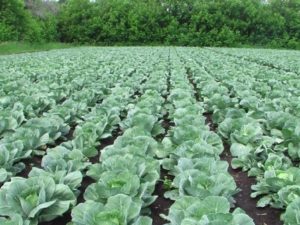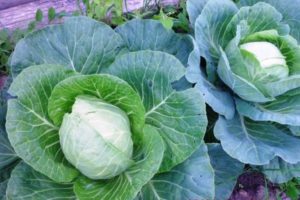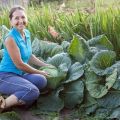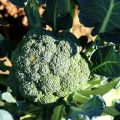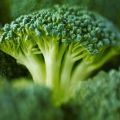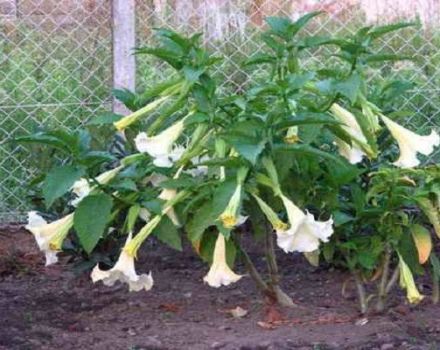Reasons why broccoli can turn color and what you can do
Broccoli cabbage contains more carotene, ascorbic and nicotinic acids, vitamins and minerals than cauliflower. White cabbage also contains fewer nutrients. Broccoli contains ingredients that prevent the onset of cancer. It is useful to eat it fresh or slightly boiled.
Broccoli is not afraid of return frosts in spring, parasites almost never attack, cabbage gives high yields. After cutting the main head of cabbage, small heads of cabbage the size of a chicken egg appear every week.
There are 2 types of broccoli: calabrese (forms a strong head of cabbage on a powerful stem), asparagus broccoli - they eat stems that taste like asparagus.
Early varieties
Emperor F1 - 75 - 80 days pass from the growth of the first shoots to harvest.
Comanches - the heads are cut 3 months after planting the seeds. The bushes tolerate low and high temperatures well.
Laser F1 - the heads of broccoli cabbage, dense and emerald green, are removed after 75 days.
Summe King - the variety easily tolerates heat. Gather a high yield, regardless of the timing of planting.
Tonus - from the appearance of sprouts to the growth of heads, 75 - 90 days pass. The harvest ripens together. Head of cabbage is dark green, average density, weight 0.15 - 0.25 kg, has a great taste. When the weather is too cool or hot, it can have a brownish-brown color.
Mid-season varieties
Arcadia F1 is a hybrid of medium ripening, gives a large yield, vegetation period 110 days. The culture is strong and high. The head of cabbage is large, phthalocyanine-green in color, weighing up to 400 g. Cabbage can be eaten fresh and processed.
Genoa - great for tighter planting.
Greenbelt - vegetative period 105 days. The heads of cabbage are medium, the quality is excellent, with medium-sized flowers.
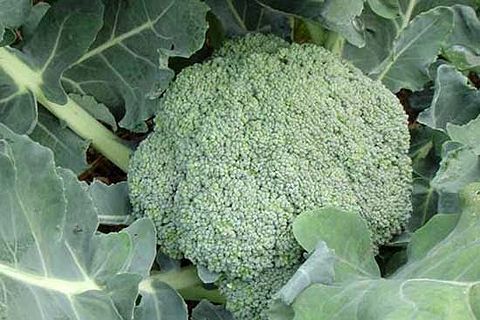
Calabrese - 90 days pass from the first shoots to technical ripeness. Heads are medium in density. The weight of the central head of cabbage is up to 400 g, after which 6 - 7 heads grow on the side of the crop, weighing up to 100 g.
Konpakta - 100 days pass from sowing seeds to harvesting heads of cabbage. The crop grows very compactly, it can be planted in heaps. The head is domed, large, with small flower buds.
Monton F1 - has a medium ripening period and a raised foliage rosette. The heads are large, weighing up to 800 g, greenish-gray, medium density, good taste.
Senshi - vegetative period 110 days. The head of cabbage is large, in the shape of a dome, with medium-sized flower buds, the cabbage lies after harvest for a long time.
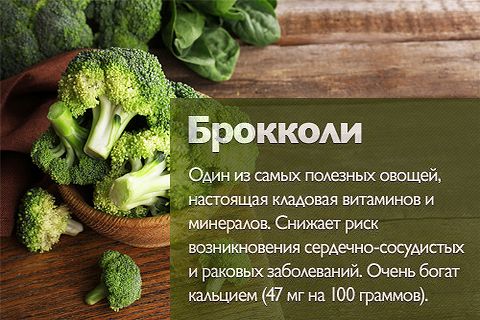
Fortune - the variety has an average ripening period and a raised foliage rosette. Head of cabbage is greenish-gray, medium density, weight up to 150 g, good taste.
Caesar - has large, hard, greenish-purple heads.
Late varieties
Lucky F1 - has a late ripening period. The heads are large, strong, their weight is 300 - 500 g.
Marathon F1 - has a raised foliage rosette. The head of cabbage is large, weighing up to 700 g, green, strong, but with a delicate texture, good taste.
How to choose the right site and prepare the seeds
How to plant broccoli correctly so that the heads are tied?
Plant broccoli in the area where mustard, carrots, beans, potatoes, phacelia, oats, onions, lupines, beans, peas, wheat, cucumbers grew before. Do not plant on the garden bed where cabbage, tomatoes, beets, radishes, turnips, radishes grew.
Dry seeds are poured into water with a temperature of +50 ° C for a quarter of an hour, then washed in water. Pour onto a damp cotton towel and refrigerate for 24 hours. Then the seeds are dried and sown.
Sowing seeds
How to sow seeds correctly so that when transplanted into the ground, cabbage heads immediately begin to tie?
The substrate is made by mixing equal parts of turf, peat soil and sand. After sowing, the plantings are watered from a spray bottle. They are placed in a warm place with an air temperature of +20 ° C. When the first shoots appear, the air temperature is +10 ° C for 7 days. Then the temperature is increased to +14 - 16 ° С, at night - +9 ° С. If the room is too warm, above +20 ° C, this will contribute to accelerated head formation.
Excessive watering will provoke a disease called "black leg", and a lack of moisture and light will lead to the growth of dwarf heads.
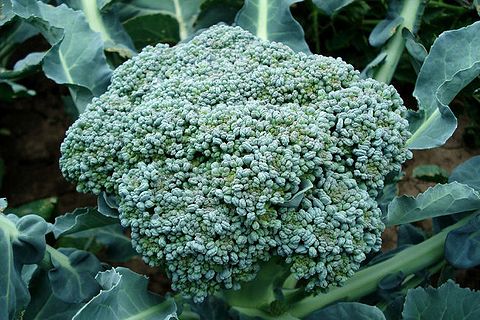
2 weeks after sowing, the seedlings are dived. After that, the air temperature should be +21 ° С, and then it is reduced to +17 ° С during the day and +9 ° С at night.
2 weeks before transplanting to the summer cottage, the seedlings are hardened by taking them out to the balcony: first for a quarter of an hour, then for a longer time.
Planting seedlings on the site
Seedlings are transplanted to the site when 5 - 6 true leaves have grown, at the age of 35 - 45 days. This is done from May 1 several times until the end of June, then it will be possible to pick cabbage from July 15 and almost until frost.
You can sow seeds in your summer cottage in early May. When planting with seeds, dig holes, add ash, water and seeds. Dusting with ash protects against insect attack.
Care
Broccoli prefers a well-moisturized soil that has neutral characteristics - this can be achieved by mulching the soil. It is advised to plant broccoli with beets, dill, peas, cucumbers, carrots, celery, spinach, tomatoes, marigolds. It is not recommended to plant broccoli along with watercress and onions.
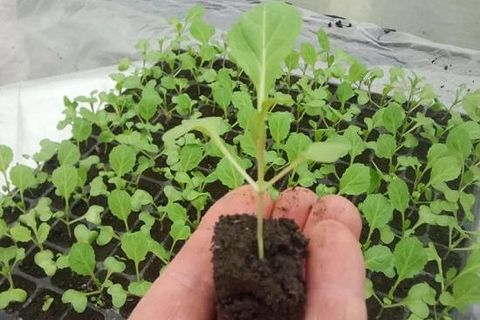
Why does broccoli turn into color? To prevent the cabbage from fading, follow the weight of the head, look at the inscription on the package with seeds: if the recommended weight of the head is 0.4 kg, then do not expect a large head, cut it off with a weight of 0.35 kg, then the cabbage will not bloom. Cut the head of cabbage with a knife, do not touch the side foliage. Fertilize the crop, and after a while, side shoots will grow.
Why are heads not forming? If the heads are not tied in any way, then you need to remember that they grow at an air temperature of up to +18 ° C. That is, late ripening broccoli varieties must be sown so that the heads form when the air temperature is not too high. In September, when the nights are cool enough, the head of cabbage develops more slowly, but as a result grows larger.
Remember that cabbage loves water and drought will be bad for head development. The culture is especially demanding for watering, when a rosette of foliage forms and a head of cabbage forms.
What to do if broccoli doesn't have a head? Heads of cabbage may not start due to late or too much feeding. If you feed the plant too intensively, then the heads will not tie.
Why is broccoli not ovary? The reason why broccoli does not make a head of cabbage is a lack of moisture. Another reason is the lack of fertilizer. If the cabbage is missing something, then the culture "decides" that there is no point in forming heads of cabbage, and the cabbage will go into bloom.
The last reason is too hot. Cabbage does not like the heat, because of this, when you buy seeds, read on the package if it is advised to plant this variety in a particular area. In the south, broccoli is planted in the fall and harvested in the spring.
Broccoli is fed three times: 14 days after planting the seedlings, then after another 2 weeks and when heads are formed. It is better to use a vermicompost solution and herbal tea for fertilization.
What can be done to make the heads grow well? Mulch the plantings with peat and dust the peat with ash. In order for the heads to be dense, it is necessary that direct sunlight does not fall on them. That is, when tying a head of cabbage, break the rosette of leaves or tie the leaves over the head.
Remember it is best to plant broccoli seedlings later in the garden and in the greenhouse in April or May.
